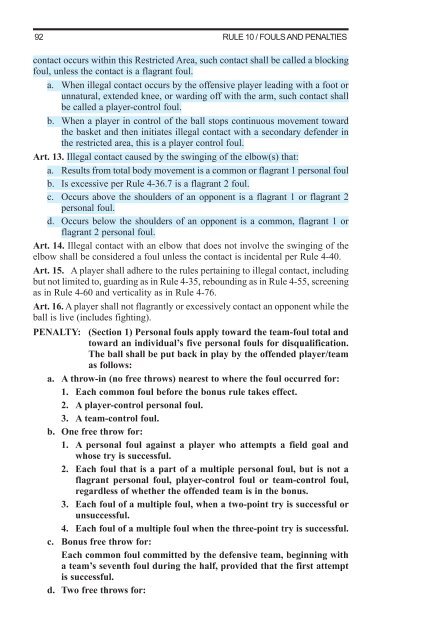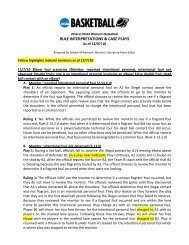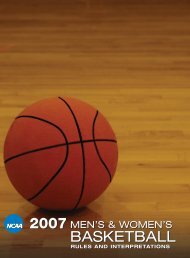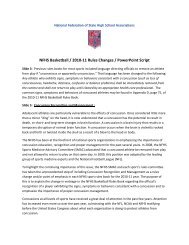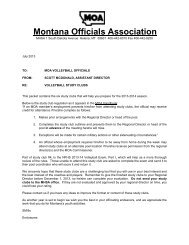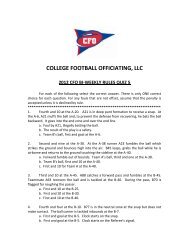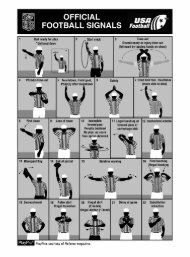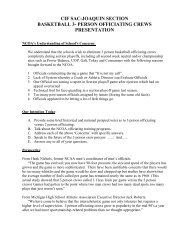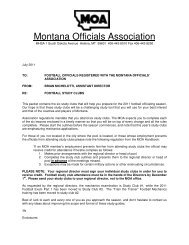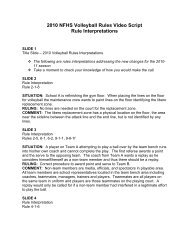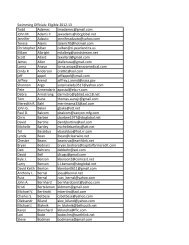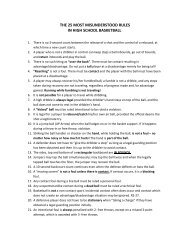2011-12 AND 2012-13 MEN'S AND WOMEN'S RULES - NAIA
2011-12 AND 2012-13 MEN'S AND WOMEN'S RULES - NAIA
2011-12 AND 2012-13 MEN'S AND WOMEN'S RULES - NAIA
Create successful ePaper yourself
Turn your PDF publications into a flip-book with our unique Google optimized e-Paper software.
92<br />
RULE 10 / FOULS <strong>AND</strong> PENALTIES<br />
contact occurs within this Restricted Area, such contact shall be called a blocking<br />
foul, unless the contact is a flagrant foul.<br />
a. When illegal contact occurs by the offensive player leading with a foot or<br />
unnatural, extended knee, or warding off with the arm, such contact shall<br />
be called a player-control foul.<br />
b. When a player in control of the ball stops continuous movement toward<br />
the basket and then initiates illegal contact with a secondary defender in<br />
the restricted area, this is a player control foul.<br />
Art. <strong>13</strong>. Illegal contact caused by the swinging of the elbow(s) that:<br />
a. Results from total body movement is a common or flagrant 1 personal foul<br />
b. Is excessive per Rule 4-36.7 is a flagrant 2 foul.<br />
c. Occurs above the shoulders of an opponent is a flagrant 1 or flagrant 2<br />
personal foul.<br />
d. Occurs below the shoulders of an opponent is a common, flagrant 1 or<br />
flagrant 2 personal foul.<br />
Art. 14. Illegal contact with an elbow that does not involve the swinging of the<br />
elbow shall be considered a foul unless the contact is incidental per Rule 4-40.<br />
Art. 15. A player shall adhere to the rules pertaining to illegal contact, including<br />
but not limited to, guarding as in Rule 4-35, rebounding as in Rule 4-55, screening<br />
as in Rule 4-60 and verticality as in Rule 4-76.<br />
Art. 16. A player shall not flagrantly or excessively contact an opponent while the<br />
ball is live (includes fighting).<br />
PENALTY: (Section 1) Personal fouls apply toward the team-foul total and<br />
toward an individual’s five personal fouls for disqualification.<br />
The ball shall be put back in play by the offended player/team<br />
as follows:<br />
a. A throw-in (no free throws) nearest to where the foul occurred for:<br />
1. Each common foul before the bonus rule takes effect.<br />
2. A player-control personal foul.<br />
3. A team-control foul.<br />
b. One free throw for:<br />
1. A personal foul against a player who attempts a field goal and<br />
whose try is successful.<br />
2. Each foul that is a part of a multiple personal foul, but is not a<br />
flagrant personal foul, player-control foul or team-control foul,<br />
regardless of whether the offended team is in the bonus.<br />
3. Each foul of a multiple foul, when a two-point try is successful or<br />
unsuccessful.<br />
4. Each foul of a multiple foul when the three-point try is successful.<br />
c. Bonus free throw for:<br />
Each common foul committed by the defensive team, beginning with<br />
a team’s seventh foul during the half, provided that the first attempt<br />
is successful.<br />
d. Two free throws for:


